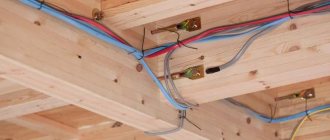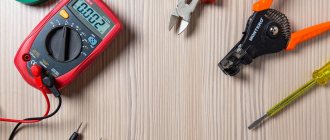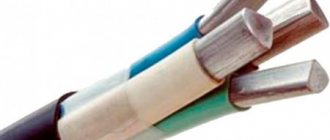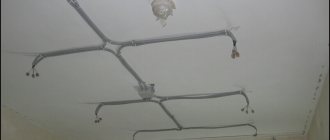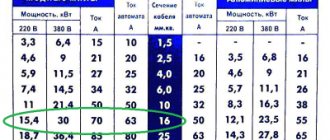There are a variety of wires on sale, differing in material, cross-section, marking, design and color.
When laying electrical systems, it is necessary to resolve the primary issue - which cable to use for wiring in the apartment in order to ensure the safety and reliability of the laid electrical communications.
Agree, choosing a suitable conductor is not an easy task. We will try to help you, and we suggest you familiarize yourself with the detailed classification of cables and the specifics of connecting electrical equipment.
Reasons for replacing cables
Complete or partial replacement of electrical networks usually needs to be performed in two cases:
- Wiring age . Major renovations are recommended to be carried out 15-20 years after moving into a new apartment. During this time, the installed communications wear out, becoming a source of potential danger for residents.
- Redevelopment and renovation of premises (especially with the addition of powerful household appliances). Modern electric stoves, washing machines, and dishwashers place increased demands on wiring. It is not advisable to connect them to old electrical networks due to the mismatch of characteristics. When planning to purchase such units, it is better to update communications in individual rooms, for example, in the kitchen or bathroom.
Regardless of the reason for replacing electrical networks, work should begin with drawing up an electrical wiring diagram and selecting cable products.
Differences between cables and wires
Novice craftsmen often ask the question of what to buy for laying electrical communications - cables or wires.
To solve this problem, you need to find out the difference between these products:
- According to GOST 15845-80 adopted in the USSR, the cable consists of one or more conductors (cores) coated with insulating material. Such elements, in turn, are enclosed in a plastic, polyethylene, metal or rubber shell, on top of which an additional protective cover, including an armored one, can be installed.
- Thanks to double insulation, the cable is reliably protected from moisture, light, exposure to aggressive substances, and mechanical damage. Increased strength and reliability characteristics allow the use of such products in the most difficult conditions, for example, under water and underground.
- The wire consists of one or more twisted strands, which can be either insulated or bare. They are usually enclosed in a non-metallic sheath (PVC, cross-linked polyethylene) or a braid/winding made of textile or wire. The security of a wire is much less than that of a cable, so its scope of use is quite limited.
According to professionals, to install a stationary electrical network in an apartment, it is necessary to use only cables. The wires can be used for portable electrical equipment, as well as in low-current systems with a voltage not exceeding 24V.
Wires differ from cables in having bare cores and a lighter protective sheath. They can be used to create electrical systems that do not have high requirements
When choosing materials for laying electrical networks in residential premises, preference should be given to impeccably high-quality products. Only in this case can you install safe, fire-resistant and reliable wiring that will ensure the delivery of electric current to every corner of the apartment.
Copper or aluminum conductor?
Cables used to lay electrical networks in a house or apartment are usually equipped with aluminum or copper conductors. Although you can still find users who use cables with aluminum conductors, the copper option is now considered safer and more effective, since copper has high conductivity, less brittleness when repeatedly bent, and high resistance to corrosion.
If we consider an aluminum core, although it has the necessary electrical conductivity and heat transfer, it oxidizes quite quickly when air enters, forming a dielectric - a refractory dark gray film, due to which excessive heating of the contact occurs, further increasing the electrical resistance. As a result, the contacts will melt, the power supply will be of poor quality, or the circuit will even break. In addition, the aluminum core is very brittle when the cable bends. Over time, the insulating material can crack, allowing air to enter and speeding up the process of oxidation and corrosion.
There are also restrictions on connection with other types of conductors. For example, old aluminum wire cannot be directly connected to copper wire, as this may cause electrolysis. After all, metals have different chemical properties and linear expansion. As the room temperature or current changes, the connection point will gradually weaken and the connection will begin to overheat.
Pros and cons of aluminum cable
| Minuses | pros |
| · low electrical conductivity · rapid oxidation · fragility · service life – 10-15 years | · low cost |
Due to all of the above reasons, cable products with aluminum conductors have ceased to be used in home electrical networks.
A cable with a copper conductor does not contain such a large number of negative factors. Copper has electrical conductivity significantly higher than aluminum. Copper wire is more flexible and mechanically strong. Perhaps the only drawback of this type of cable is its high cost. Some argue that there is also a problem with connecting it to other metals, but special connectors can be used for this purpose.
Pros and cons of copper cable
| Minuses | pros |
| · high price | · low resistance · less heating · less oxidation · service life – 25-30 years |
Cable cross-section for electrical wiring
The cross-section or end area of the cable cores is also important to consider when selecting it. The cross-section of the core is indicated in square millimeters. All cables have a standardized cross-sectional area, and their value will depend on the current strength. If the cross-section of the cable core is incorrectly selected, it can overheat greatly.
To make the electrical wiring at home safe, for various types of household loads it is necessary to select a cable with the following characteristics:
| Type of load | Total load power | Wire size | Circuit breaker |
| Lighting | up to 2.2 kW | 1.5 mm² | up to 10 A |
| Outlet group | up to 3.5 kW | 2.5 mm² | up to 16 A |
| Power consumer (electric stove, boiler, air conditioner) | from 3.5 kW | from 2.5 mm² and above | from 25 A |
As a rule, a core cross-section of 2.5 mm² is used for socket groups, and the load power cannot be more than 3.5 kW. In addition, the selection is always carried out with a reserve. It is also necessary to take into account operational features, for example, if the cable is planned to be laid under plaster, then there will be a need for additional cooling.
To power lamps, a core with a cross section of 1.5 mm² is usually used, since in this case the load will not have a large power.
When installing electrical networks in apartments and houses, this selection of cable is considered the most popular. In addition, this option allows you to create a power reserve, which will be useful for connecting new consumers in the future.
Existing types of products
It is difficult to unambiguously answer the question of what wires and cables are needed for wiring in the residential premises of an apartment, since such work requires various types of similar products.
According to current safety regulations, all household appliances and sockets must be grounded. Therefore, in apartments, a three-core cable is installed everywhere, having a “phase”, “zero” and “ground”
For the lighting circuit, which receives the least load from the electrical network, a cable with a cross section of 1.5 mm2 is suitable. For it, it is enough to provide a 10 A (2.3 kW) circuit breaker.
For sockets, the load in which can reach up to 3-4 kW, it is necessary to take products with a cross-section of 2.5 square meters. mm, capable of withstanding current up to 27 A and power 5.9 kW.
However, you should not load the line to such limits: for correct operation, a reserve of one third of the planned load is required. In this case, you will need a switch rated at 16 A (3.6 kW).
If you plan to install an outlet for an electric stove (hob), you need to lay a cable with a cross-section of 6 square meters. mm for power up to 10.1 kW.
In this case, it is important to select an appropriate machine designed for an electric current of 32 A (voltage 7.3 kW).
When choosing the parameters of the input cable to the apartment, it is important to take into account the power allocated to the apartment. As a rule, in this case it is necessary to use a product with a cross section of 6-10 square meters. mm.
Criterias of choice
To determine which wire to buy and use for wiring in a house or apartment, you first need to study the standard characteristics of power cables. It includes the following items:
- Cable arrangement.
- The material from which the cores are made.
- Bandwidth.
- Thickness of insulating shells.
- The quality of the marking and its color.
- Availability of certification documents.
- Appearance.
When purchasing a cable for electrical wiring in an apartment, you must remember that the selected material must comply with all provisions of the PUE. An experienced technician will help you make a choice, but in order not to act blindly, you need to study the characteristics of wires and cables yourself.
Popular types of electrical wiring
Among the frequently used types of products for electrical installation, two common models can be distinguished: VVG and NYM.
Image gallery
Photo from
Wire for electrical installation
Electrical cord for low current lines
Wire for potential equalization
Cable for connecting powerful devices
Option #1 - VVG cable
The most popular domestically produced product, which is often used to perform electrical work in an apartment. The cable belongs to unarmored flexible power wires.
It can consist of 1-5 copper cores, the cross-sections of which vary from 1.5 to 240 square meters. mm. The conductors, which can be round, triangular or flat, are surrounded by polyvinyl chloride insulation and a common sheath.
The VVG cable has several modifications:
- VVG is the main type, the characteristics of which are given above.
- VVGng is a power cable that has an outer sheath and core insulation made of non-flammable polyvinyl chloride.
- VVGng-LS - wiring, the conductors of which have non-flammable self-extinguishing insulation, and the shell has a low smoke emission rate.
- VVGng FR-LS is a non-flammable cable with low smoke emissions, which has additional fire protection made of mica tape.
Although regular VVG is cheaper, its shell does not have fire-resistant properties and emits a lot of smoke when burning. These products are also not suitable for bundle laying, while non-flammable products are mounted in bundles, so that several cable lines can be laid simultaneously in corrugations, pipes or pits.
The same type of product (for example, VVGng cable) produced by different enterprises may have slight differences in appearance and technical characteristics
Based on the reasons listed above, for wiring electrical networks in an apartment, it is better to take reliable and practical products of the PPGng-HF and VVGng-LS brands, which are the safest in domestic operating conditions:
Image gallery
Photo from
Cable products marked VVGng-LS
Burning and toxin-emitting cable
Cable with halogen-free insulation PPGng-HF
VVGng products for laying grooves and technical premises
Option #1 - NYM cable
These are copper products manufactured at Russian factories under a German license. The cable complies with both domestic GOST standards and European standards.
According to the main characteristics, the model coincides with the indicators of the VVGng cable; it is also rated for a nominal voltage of 0.66 kW.
On sale there is a single-wire multi-core NYM cable with a cross-section of 1.5-10 mm2 and a multi-wire cable with a cross-section exceeding 16 mm2.
To ensure the non-flammability of the product, a rubber filler is placed between the polyvinyl chloride shell of the product and the cores (1-5) insulated with the same plastic.
NYM and VVGng wires have a sheath made of a poorly burning polymer, due to which the insulation is prone to self-extinguishing. Another plus: when the shell burns, a small amount of smoke is released that does not contain hazardous components
VVGng and NYM cables have similar characteristics.
Their advantages include:
- High quality performance . All wiring components (insulation, cores, shells) comply with accepted GOST standards, making the products reliable and durable.
- High fire resistance and safety . Cables that meet all requirements work flawlessly under the prescribed load, and especially strong insulation allows bundle laying without the risk of fire when the cores interact.
- Easy cutting and convenient installation . The round cable packaging allows for comfortable installation, avoiding twists when laying networks. In this case, the wiring can be sealed at the terminal.
Another advantage is the large assortment of similar models, differing both in technical characteristics and in price.
TYPE AND BRAND OF WIRING CABLES
According to GOST 31565-2012, which regulates the use of cable products based on fire safety requirements, in internal electrical installations of buildings and structures, it is allowed to use cables of the following type:
ng-LS – flame retardant with low smoke and gas emissions.
ng-HF - do not propagate combustion and do not emit corrosive gaseous products during combustion and smoldering - halogens.
Currently, of this type, we have two types of cables available for use in electrical wiring :
VVGng-LS
PPGng-HF
In an apartment or private house, it is enough to use VVGng-LS; it is more widespread and more affordable than PPGng-HF.
But it is important that you understand their fundamental difference, in simple terms, at the everyday level, it turns out the following:
VVGng-LS - in the event of a fire, in the presence of an open flame, it will burn and melt, releasing dangerous chemical compounds - halogens - into the surrounding space, because Its insulation is made of PVC. And although, unlike their banned counterparts VVG and VVGng, the amount of emissions of these chemically active substances in cables marked LS (low smoking) is significantly reduced, they are still very dangerous. Even a short exposure to them on the human body can lead to irreversible changes and often these compounds are one of the causes of death in fires.
PPGng-HF - the cable of this brand uses insulation from a halogen-free composition based on polyolefins, as evidenced by the prefix HF (Halogen-Free). When burning, it does not emit potentially dangerous chemically active elements, which often allows people to evacuate from a burning building or room in time. In any case, for installation of electrical wiring, you can use both of these brands of cables.
The most common cable currently used in apartment electrical wiring is VVGng(A)-LS.
Subtleties of connecting electrical equipment
Apartment owners often need to connect large household appliances, such as an electric stove or washing machine, to a power outlet.
Flexible wires are intended for these purposes, and you should take into account clause 2.1.48 of the PUE 7 , according to which you can only take products whose purpose is indicated in the standards and technical specifications.
For example, to connect a hob, you should select a wire whose certificate contains a mention of such use of this product.
COPPER OR ALUMINUM
Any wires or cables you use in your apartment must be copper. Clause PUE 7.1.34 tells us about this, as well as SP 31-110-2003, clause 14.3
PUE 7.1.34 “Cables and wires with copper conductors should be used in buildings”
SP 31-110-2003, clause 14.3 “Internal electrical networks must be flame retardant and made with cables and wires with copper conductors in accordance with the requirements of 2.1 and 7.1 PUE.”
Which wires are not suitable?
There are product options that are strictly prohibited from being used for laying electrical networks, even in the most extreme cases. These include the following types of products.
Product #1 - PVS wire
Copper connection element having a PVC sheath and insulation. It has a stranded design with 2-5 conductors with a cross-section of 0.75-10 sq. mm.
The wire, designed for a voltage rating of 0.38 kW, can be used to connect household electrical appliances to the power grid and for making extension cords.
PVA is not suitable for laying wiring for the following reasons:
- It has a multi-wire core structure, so it requires tinning and soldering to connect the ends, which requires a lot of time and a lot of experience.
- The product creates a fire hazard: the wire strands cause the cable to heat up more, causing the insulation to wear out faster, which can lead to a short circuit.
- PVA cannot be laid in a bundle, whereas almost all cable models are suitable for this. Due to the fact that the wiring lines must be at a certain distance from each other, you will have to make grooves in the wall for each of them.
Thus, even the low price of such wires cannot compensate for the high installation costs, and the quality of the installed electrical network will not be too high.
Product #2 - SHVVP, PVVP wires
Cords or cables having single or multi-wire copper cores can be used to connect household appliances and electrical equipment.
However, they are not suitable for fixed electrical communications because these products do not have non-combustible insulation.
Although a flat cord with polyvinyl chloride sheaths (SHVVP) is not recommended for laying electrical networks, it is quite suitable for organizing low-current lighting up to 24V, namely for laying wiring from a transformer to LEDs
In addition, the service life of SHVVP and VPPV is quite short, and the multi-core design requires processing of the ends and soldering during installation.
It is also worth mentioning PUNP (universal flat wire), which was banned for laying electrical networks in apartments back in 2007.
This outdated product has poor insulation and low power, making it unable to withstand modern loads
How to choose the right cable?
Undoubtedly, the quality of the elements used greatly affects the operation of the entire electrical system. The higher the quality, the better the power grid works, that is, without interruptions. Therefore, it is very important to choose the right cable so that it is of the proper quality.
In the cable marking, the manufacturer always specifies the material from which the cores are made and what the insulation is made of.
The product labeling should be carefully studied before purchasing a cable. The cable must contain the following information:
- brand;
- manufacturer's name;
- compliance with GOST or technical specifications.
The cross-sectional dimensions and cable grade must be repeated along the entire length of the outer cable braid at regular intervals.
The electrical cable marking contains numbers and three letters. The first number corresponds to the number of cores in the cable, the second number is the cross-sectional area of each core, and the third is the calculated network voltage. Other numbers indicate the flexibility class.
As for the letters, the first letter is the type of material used for the top braid of the insulation, the second is the type of wire, the third is the type of material for the internal insulation of the cores.
If the letter “A” is in the first place in the cable marking, then this wire has cores made of silver metal, that is, aluminum. If the letter “A” is missing, the cable uses copper threads.
The type of wire is indicated by letters:
- “K” – control;
- “P” – flat;
- “Ш”, “У” – installation;
- “M” – installation;
- “MG” – mounting with flexible core.
Designations and explanation of internal insulation of cores:
- “B” or “BP” – rubber braid insulation;
- “P” – polyethylene insulation;
- “Pv” – vulcanizing polyethylene is used;
- “Ps” – self-extinguishing polyethylene is used;
- “C” – lead outer braid.
The rubber insulating layer can be protected by a polyvinyl chloride “B” sheath or a nyrite “N” sheath.
Sample decoding of cable designation VVG 4x2.5-380. The cable has four copper cores, each core with a cross section of 2.5 mm. The cable is designed for a voltage of 380 V. The copper conductors are insulated with polyvinyl chloride braiding and enclosed in an outer sheath of PVC.
Conclusions and useful video on the topic
This video provides detailed information on the selection of products for organizing electrical wiring in residential premises:
Despite the wide variety of products, it is quite easy to select the necessary material for laying electrical communications. You need to carefully read the markings, tags and product certificates, pay attention to the technical characteristics and quality of the cable .
Share with readers your experience of wiring in an apartment, tell us what cable you used. Please leave comments on the article and ask questions that interest you. The feedback form is located below.
Cable arrangement
Based on the method of manufacturing current-carrying cores, cables are structurally divided into two main types: single-wire and multi-wire. Solid core uses one solid wire, which makes the cable more rigid and susceptible to frequent kinks. Stranded ones consist of many small veins woven together - this makes the wire flexible and can withstand repeated kinks.
The manufacturing technology of stranded wires is somewhat more complicated, so such wires are more expensive than single-wire wires, but in terms of current-carrying properties they are approximately equal (if you don’t delve into high-level matters, such as “spreading of current over the surface of a conductor” and so on).
It is impossible to answer unambiguously which wire according to the design to choose for wiring in an apartment, since theoretically both varieties can be used as electrical wiring with some reservations. If funds allow, they still try to use cables with multi-wire cores, since they are more flexible and better suited for external and hidden methods of laying wires at the same time. Their disadvantage is the need for additional tinning of the ends of the wire when installing sockets - otherwise the contact may deteriorate over time.
The different types of cables are discussed in detail in the following videos:

